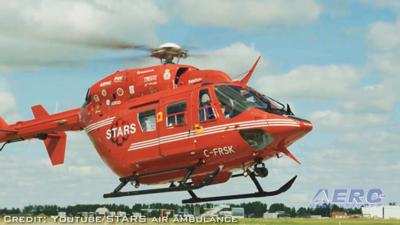Air Ambulance Operators Struggling to Maintain Services
While traveling a Manitoba highway on 28 May 2017, Dawn Sabeski suffered a head-on collision with an oncoming motorist. Sabeski's passenger died on impact; Sabeski was taken to a rural hospital in western Manitoba.

Her injuries, however, were extensive—internal bleeding and multiple fractures—and exceeded the hospital’s ability to adequately treat. That Dawn Sabeski was in need of advanced medical care was a mortal certainty. Ergo, she was transported by Helicopter Air Ambulance (HAA) to the Health Sciences Centre in Winnipeg. The helicopter, pilots, and medical personnel were provided by STARS air ambulance—an acronym for Shock Trauma Air Rescue Service.
"I would not have made it [had I been] transported by [ground] ambulance to HSC. I wouldn't have made it," said Sabeski, a resident of East Selkirk, Manitoba.
Vast expanses of rural Canada rely on air ambulance services and the skilled pilots by which such operations are staffed. Regrettably, the number of helicopter pilot licenses being issued by Transport Canada has declined precipitously over the last decade. The egregious shortfall has raised concerns over the future of Canada’s air ambulance services.
In 2012, Transport Canada licensed 62 new helicopter pilots. A decade later, in 2022, the agency issued only 12 such licenses—a decline of eighty-percent.
John Gradek, an aviation expert at Montreal’s McGill University posits the dramatic drop in the issuance of rotary-wing licenses is attributable to numerous factors. Gradek, who coordinates the school's aviation management program, states veteran pilots have alternately retired or been headhunted by regional and national airlines facing pilot shortages of their own. Gradek also cited the high cost of pilot training, which often exceeds $100,000.
"It is an expensive career choice," Gradek remarked, adding that higher pay could be one way to attract those considering a career in the cockpit.
Gradek observed that air ambulance services are expanding across rural Canada, and the demand for pilots to man the cockpits of future helicopter fleets stands to increase in accordance.
"Unfortunately, we may be in a situation where we have to ration the availability of ambulance pilots to, in fact, kind of temper the growth that the provincial governments want to see in air ambulance services," Gradek suggested.
Cade Clark, vice-president of government affairs for the Virginia-based Helicopter Association International stated his organization is about the endeavor of promoting the aviation industry to high school students.

"How do we reach out to high school kids, let them know that this industry is wide open and available for them? Mr. Cade set forth. “And as we bring in new students, how do we help them through that pipeline?"
Clark noted the helicopter pilot shortage is not unique to Canada, and pointed out the paucity of qualified pilots—fixed and rotary wing alike—is being felt in the United States and around the globe.
"When we're not available, the public suffers, and that's a pretty black-and-white issue," Clark opined. "We are truly life-saving, and so when vertical aviation is not available to service the public, there are real-world consequences. ... Our operators are taking this very seriously as we look, as an industry, at how to address this issue."
A spokesperson for the Virginia State Police reported in August 2022 that the prevailing dearth of quality aviators had compelled the department to reduce air ambulance service at one of its bases from 24/7 to only 16-hours a day.
Veteran helicopter pilot Ryan Shrives, whose 24 years of cockpit experience has rendered him eminently employable, asserts he is regularly headhunted, stating: "Five years ago, you were begging. You would be handing out CVs, trying to beg for a job. Nowadays, if you've got experience, if you've got time on the aircraft and a lot of training in different fields, the guys are calling you weekly. I've had other medevac companies—and I'm not lying when I say—they call us weekly."
Shrives has flown for HALO Air Ambulance’s Medicine Hat, Alberta division for some three-and-a-half years. Formerly, he served as a helicopter pilot for both the South African Air Force and the United Nations.
HALO CEO Paul Carolan disclosed that his company had lost seven pilots in the last two years, four of which took positions with competing air ambulance operators and three of whom left the industry altogether.
Mr. Carolan stated: "If the call comes in right now, we have to be prepared to go. So having those people on-site and ready is always a factor, and it's a fundamental part of who we are. So it's not that it's harder, but it certainly makes things a bit more complicated."
HALO has replaced the aviators it lost, but Carolan conceded that pilot recruitment remains a constant concern.
"We're looking at every opportunity and talking to every person and trying to make sure that we stay competitive in an extremely competitive market," the beleaguered CEO confided. "There is only one position that matters when it comes to what we do, and that is the ability to fly the aircraft. Whether you have clinicians in the back, it doesn't matter if you can't get them there."
 ANN's Daily Aero-Linx (05.02.24)
ANN's Daily Aero-Linx (05.02.24) ANN's Daily Aero-Term (05.02.24): Touchdown Zone Lighting
ANN's Daily Aero-Term (05.02.24): Touchdown Zone Lighting Aero-News: Quote of the Day (05.02.24)
Aero-News: Quote of the Day (05.02.24) ANN FAQ: Contributing To Aero-TV
ANN FAQ: Contributing To Aero-TV NTSB Final Report: Cirrus Design Corp SR20
NTSB Final Report: Cirrus Design Corp SR20




